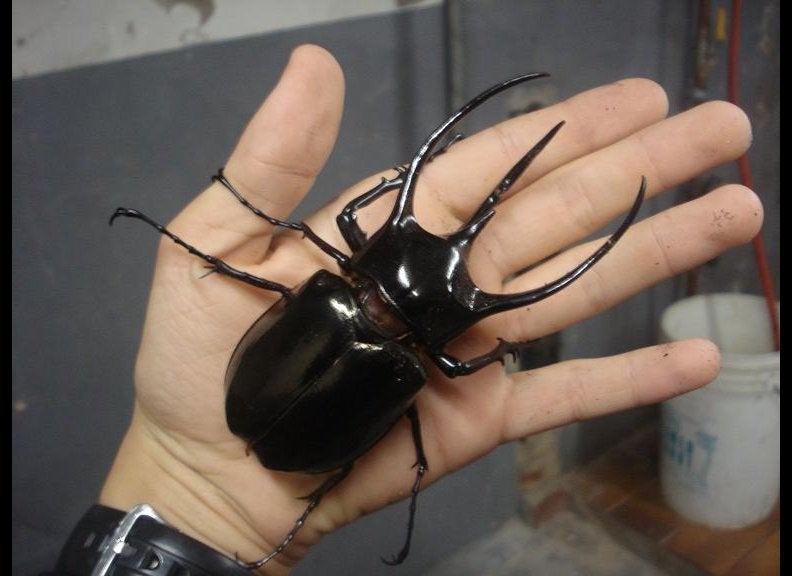By Virginia Morell
Figaro may not be as talented an inventor as Leonardo da Vinci, but among Goffin's cockatoos, he's a prodigy. In their natural habitat—the forests of Indonesia—these cockatoos have never been seen making or using tools. But researchers report today that Figaro, a member of a captive colony of the birds in Austria, invents and uses stick tools of his own design. Although toolmaking and use is not uncommon in animals, this type of spontaneous innovation and individual creativity is "exceedingly rare" among nonhuman animals, the scientists note, and opens up many questions about the cognitive skills required. Understanding these processes, they say, may help unlock many questions about the evolution of intelligence.
Many species of birds, such as woodpecker finches of the Galapagos Islands, ravens, crows, and herons, are natural toolmakers and users. New Caledonian crows are especially talented, shaping bits of wood and stiff palm leaves into spears and hooks to forage for grubs. One captive New Caledonian crow displayed an inventiveness similar to Figaro's by fashioning hooks (a shape she had not previously seen) out of wire. And captive Northern blue jays, which are not tool-users in the wild, have shredded newspaper to use as rakes for retrieving food pellets.
Such talents haven't been seen before in cockatoos—and although tool use is seen in many species, innovative tool manufacture is rare. But even if Figaro is a standalone talent among his species, says Frans de Waal, a primatologist at Emory University in Atlanta, the discovery of such skills in even one individual shows that "general intelligence can lead to innovative behavior." Inventiveness is thus not tied to some type of mental specialization, such as being a natural tool-user, as has been argued previously, he explains.
Figaro's unusual talent came to light when a student observer at the University of Vienna's Goffin Lab noticed the cockatoo playing with a pebble. The bird dropped the stone through the aviary's wire mesh, where it landed on a wooden beam. Figaro tried to retrieve the stone with his claw. When that failed, he picked up a piece of bamboo and used it to try to rake the stone back into the aviary—but did not succeed. "That very day, as soon as my student told me about this, we isolated Figaro," placing him in a separate aviary with a female companion named Heidi, says Alice Auersperg, a cognitive biologist, and the lead author of the new paper. (The researchers did not want Figaro's new talent—tool use—to spread to other birds via social learning.) Hoping that they would be able to film Figaro repeating his unexpected behavior, the scientists placed a nut on the wooden ledge outside his new enclosure in exactly the same position as the pebble had been. "We never imagined that we were about to witness tool manufacture," Auersperg says. "But that's exactly what he did."
After trying and failing to reach the nut with a tiny stick he found on the aviary floor, Figaro set about making what he needed. With his beak, he ripped off a large splinter from the wooden beam, a task that took him almost 25 minutes. Holding his tool in his beak, he eventually raked the nut to a spot where he could grab it with his tongue and beak (see video). "He'd never seen a tool like this, yet when he needed one, he made it," says Alex Kacelnik, a behavioral ecologist at the University of Oxford in the United Kingdom and another author on the paper, which appears online today in Current Biology. The scientists gave Figaro nine additional trials, and he made the tool required in all cases, except one, when he used a piece of bamboo from the floor. In one instance, he trimmed the side branches from a twig and attempted to use it as a rake—only to discover that the twig was too long. He then removed it and cut it twice with his beak, making a tool of exactly the right length.
"He did everything: tool use, tool manufacture, and tool modification," Auersperg notes, "and he made them so quickly. His second tool took him less than 5 minutes to make, which is a drastic reduction." Two other cockatoos (Heidi and Pipon) were also tested, but neither succeeded at the task—although Heidi, who had witnessed Figaro at work, did break off small pieces of wood and inserted them through the mesh.
What mental processes Figaro used to invent and make his tools is not understood, the scientists say, although they hope in time to tease these out via experiments with him and the other cockatoos. "It's a fantastic study," says Irene Pepperberg, a comparative psychologist at Harvard University, who suggests that Figaro's talents stem in part from his playful and exploratory nature—something cockatoos are known for. "They are the orangutans of the parrot world," she says.
Parrots in general "have big brains, are social, and long-lived—attributes that foster innovative, cognitive problem solving," adds John Marzluff, a wildlife biologist and expert on crow cognition at the University of Washington, Seattle. With food easily available in the wild, parrots don't need to be inventive, he notes. "But put that same mind behind bars and give it a reason to make a tool, and bingo, a tool is made. It makes you wonder what other thoughts are rattling around the brains of pet parrots everywhere!"
ScienceNOW, the daily online news service of the journal Science
